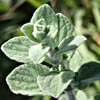Majorana syriaca (Wild Marjoram) is an herb that comprises the main component of a mixture known as “zaatar”. It is easily recognized by its appearance and its scent. It is a white-grayish dwarf-shrub and reaches a height of 40 cm. Its leaves are opposite, small, broad ovate, felty. Their veins are prominent on the lower side. The leaves are shed in the summer, and smaller leaves grow in their stead, which resemble the winter leaves in their appearance and in their scent. The stem is not square in cross section, as are most of the members of its family, but is rather almost round. The young stems are reddish.
Wild Marjoram blooms for a long time, in the spring and summer, from April until September. The calyx is unilabiate, cleft from the front. The corolla is bilabiate and small (4 mm). It is white or somewhat purplish. The flowers are arranged densely in spike-like inflorescences. They do not look magnificent, but abound with nectar and buzz with pollinators. They are pollinated by a large variety of insects, including wasps, flies, ants, flower beetles, butterflies and small bees.
Wild Marjoram is a common species. It grows in most Mediterranean parts of Israel, in fallow land, bathas and garigues, on limestone and chalk rocks. Its global distribution spreads over the countries east of the Mediterranean Sea.
It is accepted that this species is indeed the hyssop mentioned in the Bible. Hyssop was used to purify the Alter in the Temple, to purify lepers, etc. Today Marjoram is also attributed with qualities such as prevention of blood clotting (this has been proven as untrue), improvement of memory, relief of colds and relief for labor contractions.
Two types of this species have been discerned in Israel, which differ from each other in the composition of the essential (ethereal) oil, which is the substance that imparts the leaves with their scent. There are no other differences between the two types, except for the scent. Most of the scent material is stored in glandular hairs on the leaf surface. When the leaf is plucked and ground between the fingers these hairs are torn and the oil in them pours out, and the scent can be discerned from a distance.
A comparison between names is interesting. In Arabic the term “zaatar” refers to both Marjoram (hyssop) and to some other genera in its family, whose scent and taste are similar and which can be used as substitutes for Marjoram in the kitchen, including thyme, satureja and savory. The mixed spice, which in addition to Marjoram contains sesame, salt and sumac, is also called “zaatar”. It is also possible that our ancestors, when speaking of hyssop, referred to all the genera in the Lamiaceae family that have a similar scent. Today we have adopted the scientific method established by the Swede Linnæus, who stated that each genus has a different name. The genus Majorana contains 6 species. Only one species grows in Israel. Marjoram is so common in Israel that it thrives in spite of intensive picking for use as an herb and a medicine. However, after sacks of it were picked for commerce and export, its existence became endangered, and it has been declared a protected plant, which is forbidden for commercial picking but permitted for domestic use.
Written by Mike Livne








